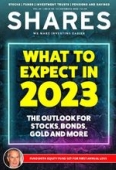Archived article
Please note that tax, investment, pension and ISA rules can change and the information and any views contained in this article may now be inaccurate.
Four funds and investment trusts to buy for income and capital growth in 2023

Alena Kosava, head of investment research at AJ Bell, offers a selection of fund and investment trust ideas for different types of investors.
One for cautious investors
Personal Assets Investment Trust (PNL)
Personal Assets is a solid choice for investors looking to protect and increase the value of their investment over the long term. The trust has generated steady returns over the years and tends to do particularly well amid challenging market conditions and souring economic narrative.
With a heavy sell-off across equity markets and material repricing across the bond universe underpinned by fears over persistently elevated inflation for a considerable period, the defensive positioning of this trust, and in particular its exposure to inflation protecting assets such as gold and inflation-linked bonds, hold appeal.
The portfolio shape is relatively unchanged from a year ago with c.9% in gold bullion and 37% in US index-linked bonds supporting the core exposure to high quality equities.
As a result, the trust works well in providing investors with a multi-asset diversified portfolio. Given the emphasis on capital protection, it should sit comfortably with cautious investors.
One for Balanced investors
First Sentier Global Listed Infrastructure (B24HJL4)
Following the emergence from hibernation following the Covid lockdowns of 2020 and economic reopening, we’ve seen an acceleration in inflationary pressures around the world as supply chains came under pressure.
Having underestimated the inflationary outlook, central banks are finally realising the realities around stubborn persistence of inflation globally. This has resulted in a steep rate hiking cycle and a precipitous rally in bond yields, weighing on economic growth.
As the prospect of recession is staring investors in the face, the importance of portfolio diversification in the form of real assets such as high-quality infrastructure has been clearly evidenced.
Whether it is through energy needs, distribution networks or communication services, infrastructure is a key part of a fully functioning economy.
Amid the ongoing war in Ukraine, the importance of energy security and independent infrastructure assets also came to the fore. The First Sentier Global Listed Infrastructure fund looks to provide exposure to these areas and more in a global portfolio of infrastructure companies.
With over 40% invested in energy related companies, it provides exposure to many who are leading on energy transformation while also giving exposure to critical distribution infrastructure such as railways and toll roads.
The portfolio is biased to the US sector (c.58% of assets) and has material exposure to electric utilities (30%), highways and rail tracks (15%) and multi-utilities (14%). It is currently yielding 2.5% and has a 0.8% ongoing charge.
The fund benefits from the experienced team at First Sentier based in Australia who have been at the forefront of infrastructure investing for many years. The fund is ahead of its benchmark index year-to-date, having kept up with the market rally from the lows in March, delivering a gain of 8.8%, relative to the index gain of 7.3%. Longer term performance is also ahead of the broader market.
One for Adventurous investors
JPM Emerging Markets Income (B5T0GN0)
While emerging market equities have suffered material underperformance over the last few years, this has largely been driven by steep losses in China.
Amid numerous challenges, including property sector rebalancing, common prosperity narrative, geopolitical risks around Taiwan and Covid lockdowns to name but a few, investors may feel nervous.
China is likely to start emerging from its zero-Covid policy in due course, as it cannot continue to pursue the regime indefinitely. Furthermore, while western central banks are fighting inflation in full force, emerging economies were swift to react and raised rates earlier, with many regions now in a position to start easing policy.
Inflation coming off from its peak in the US might also signal a change in the stance for the Fed, as it continues tightening policy, potentially at a slower pace. This might mean a pullback in the US dollar, which should also be supportive for emerging markets.
An equity income approach at the current juncture appears attractive, offering some cushioning in the form of regular dividends. JPM Emerging Markets Income fund currently yields 4.4% and offers the potential for capital gains on top.
Diversified across c.90 names, the fund offers sufficient compositional breadth, whilst ensuring diversity of drivers underpinning its dividend. It has a 1.15% ongoing charge.
One for income seekers
Jupiter Asian Income (BZ2YMT7)
Dividends have long played a key role in shareholder returns across Asia and the Jupiter Asian Income fund is a good way to play this theme.
Asian companies continue to be relatively well managed with low debts, helping support the fund’s dividend which currently yields 4.5% from a concentrated portfolio of 28 names.
Manager Jason Pidcock is a cautious investor, seeking out high quality companies that have strong management and governance and a clear focus on the shareholder to ensure dividends are a key part of the company strategy.
The fund has historically been significantly underweight China, before fully exiting its position earlier in the year.
Political risk has been a significant concern for many investors since the Chinese government began implementing its common prosperity policies, while heightened tensions with Taiwan proved to be the final straw for the manager.
At a country level, the fund carries a material overweight to Australia (c.35% exposure) relative to the broader index (c.18%). At a sector level, the fund is overweight energy, industrials and technology.
Over the past 12 months it has returned 11.7% versus a 0.7% decline for the Asia-Pacific ex-Japan Equity Income sector, according to Morningstar. Over five years, it has generated 8.2% annualised returns versus 3.3% from the sector.
Top holdings include Woodside Energy (WDS:ASX) within energy and materials sectors, together with technology and consumer staples names including Hon Hai Precision Industry (2317:TPE) and ITC (ITC:NSE). It has a 1.01% ongoing charge.
DISCLAIMER: Daniel Coatsworth who edited this article owns units in First Sentier Global Listed Infrastructure
Important information:
These articles are provided by Shares magazine which is published by AJ Bell Media, a part of AJ Bell. Shares is not written by AJ Bell.
Shares is provided for your general information and use and is not a personal recommendation to invest. It is not intended to be relied upon by you in making or not making any investment decisions. The investments referred to in these articles will not be suitable for all investors. If in doubt please seek appropriate independent financial advice.
Investors acting on the information in these articles do so at their own risk and AJ Bell Media and its staff do not accept liability for losses suffered by investors as a result of their investment decisions.
Issue contents
Feature
- We reveal the best performing UK stocks in 2022: large and small
- The outlook for stocks, bonds, gold and more: what to expect in 2023
- Why investors can’t afford to overlook Europe’s growth and income champions
- Discover what fund managers got right and wrong in 2022
- Bad year for investors Terry Smith and Nick Train but Warren Buffett is a winner
Great Ideas
News
- Regulators put Microsoft and Meta under scrutiny as big tech growth slows
- Chemring’s cybersecurity hidden jewel is starting to shine
- How freezing temperatures saw power prices rocket to record levels
- Why consumer squeeze and higher rental rates have clobbered Airbnb shares
- Balfour Beatty shares hit 11-year high on booming infrastructure market
- Could the Royal Mail final dividend be decided in Westminster?
- House prices cooling quickly after two years of red-hot growth

 magazine
magazine








